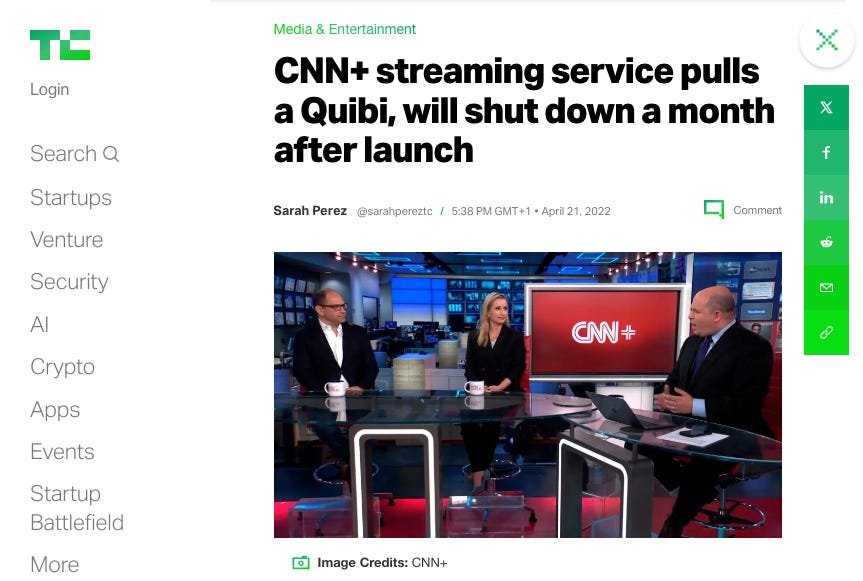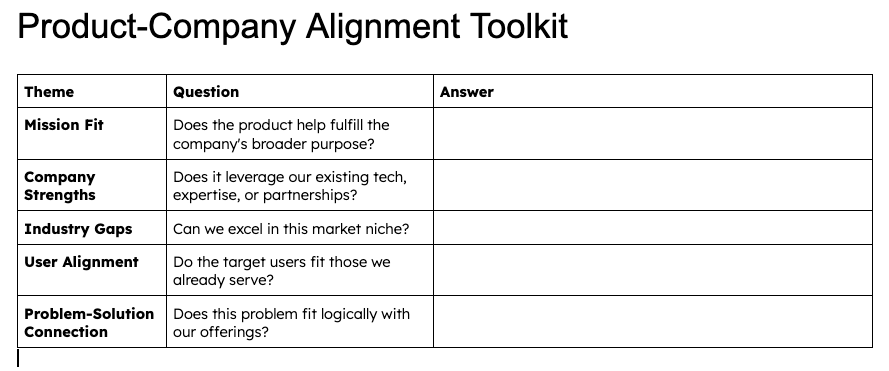A Comprehensive Framework for Rigorous Product Thinking -- Step 5: Product + Company Alignment
Does Your Idea Fit the Big Picture?
Welcome to part five of our ten-part series on rigorous product thinking. If you’re just joining us, here are links to previous posts, and a sense of what’s ahead:
Step 2: Market & Competitive Analysis
Step 3: User Segmentation
Step 4: Ideation & Solution Exploration
Step 5: Product + Company Alignment ← This post
Step 6: Validation and Prototyping
Step 7: Value Proposition and MVP
Step 8: Measurement and Learning
Step 9: Iteration and Refinement
Step 10: Scaling, Monitoring, and Continuous Improvement
The main question we’ll be answering in today’s post: How (and Why) does the product help fulfill the company's broader purpose?
Let’s get right into it.
Sarah's excited about her fitness app idea, and she’s making great progress, but before diving into development, she needs to make sure it's a strategic fit for her company. Misaligned products lead to wasted resources, internal tension, and can even damage a company's reputation. Let's help Sarah avoid those pitfalls!
Imagine this: You've poured months into a new product, only to see a disastrous launch because your marketing team wasn't equipped to promote it effectively. Or, worse, loyal customers are confused because the product feels out of place compared to your company's usual offerings. These are the real risks of not ensuring product-company alignment.
Remember Quibi? The streaming platform with big ambitions and huge funding – yet it flopped spectacularly due to a fundamental misalignment between its product and how people actually use their phones. Let's make sure your ideas don't suffer the same fate!
Even giants like CNN stumble when products clash with core strengths or market realities. Remember the rapid collapse of CNN+, their ambitious streaming service? Let's learn from their mistakes and ensure your projects achieve genuine alignment.
It's not just about sounding like a good fit. Misaligned products have real consequences:
The Launch That Flopped: Imagine spending months building a feature nobody wants because it wasn't core to the company's strengths.
Marketing Mayhem: A confusing message because the new product doesn't align with the established brand.
Diminished Returns: Struggling to reach the right customers because your ideal user is totally different from the company's existing base.
Conversely, when a product aligns seamlessly with a company's mission, strengths, and market position, good things happen:
Faster Adoption: Products that fit the brand are easier to sell and build on existing customer trust.
Resource Efficiency: Leveraging in-house tech or expertise saves time and money.
Happier Teams: Everyone feels they're working towards a common goal.
Sarah asked herself:
Mission Fit: Does the product help fulfill the company's broader purpose?
Company Strengths: Does it leverage our existing tech, expertise, or partnerships?
Industry Gaps: Can we excel in this market niche?
User Alignment: Do the target users fit those we already serve?
Problem-Solution Connection: Does this problem fit logically with our offerings?
Her company's existing wellness initiative signaled potential alignment. However, she'd need to consider the app's unique marketing needs and whether they had the necessary in-house development expertise.
Use this framework to analyze one of your current projects. Download a simple worksheet [link here] and answer the key questions honestly. Are you seeing any red flags indicating potential misalignment?
Red Flags: Watch out for:
Conflicting messages about what your company does best.
Resistance from stakeholders who don't see the value proposition.
Lack of resources to execute effectively.
Your gut tells you this doesn't fit the company's image.
To balance innovation with feasibility, Sarah also considered:
Strategic Roadmap: Could her app be part of a larger company health focus?
Potential Partnerships: Could she fill tech gaps with strategic collaborations?
Incremental Development: Can the initial product scale in line with resources?
Up Next: Validation and Prototyping
A well-aligned product is more likely to see market success and contribute to overall company growth. But alignment is just the first step! In our next post, we'll dive into data-driven validation and prototyping techniques to refine your product idea with user feedback.
Stay tuned for our next post!
Take Action
Assess a current project: How well does it align with your company's mission and capabilities?
Start a conversation: Discuss the importance of alignment with your team. Use CNN+ as a cautionary tale.
Stay tuned: Future posts in this series will arm you with tools for further product development success.
Let's Start a Conversation
How do you approach ensuring product-company alignment within your team? Share your experiences in the comments!




"Misaligned products have real consequences" - the consequences can be major!
Great stuff!